Chapter 6 Making Oral Presentations. The Role of
















































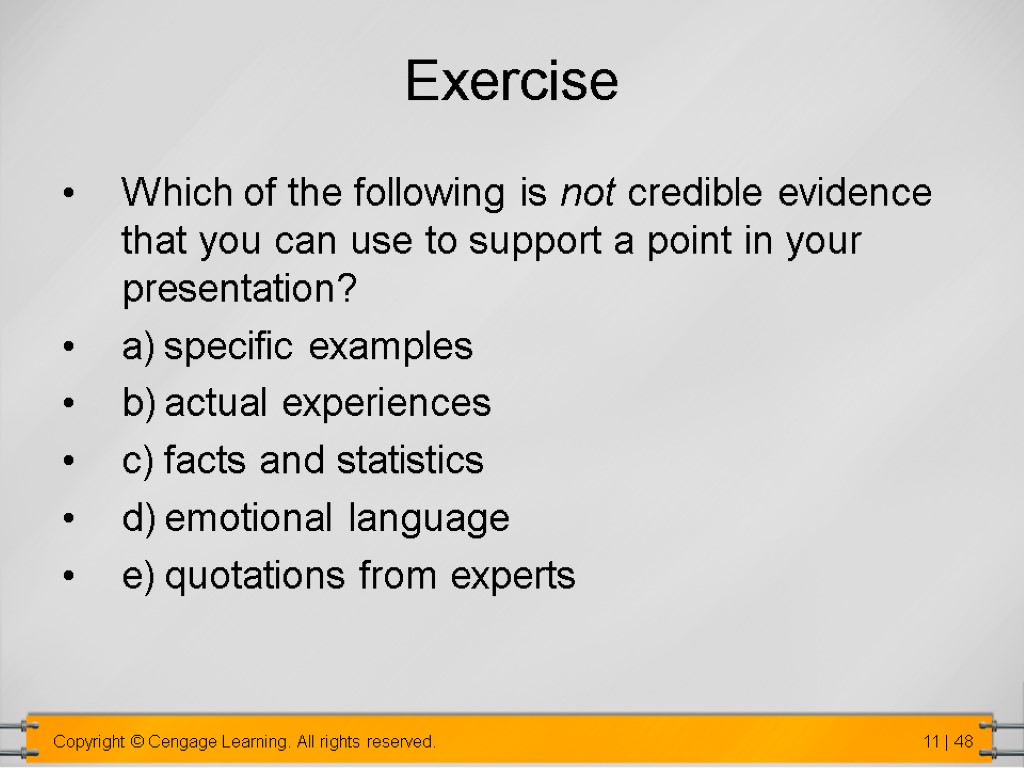

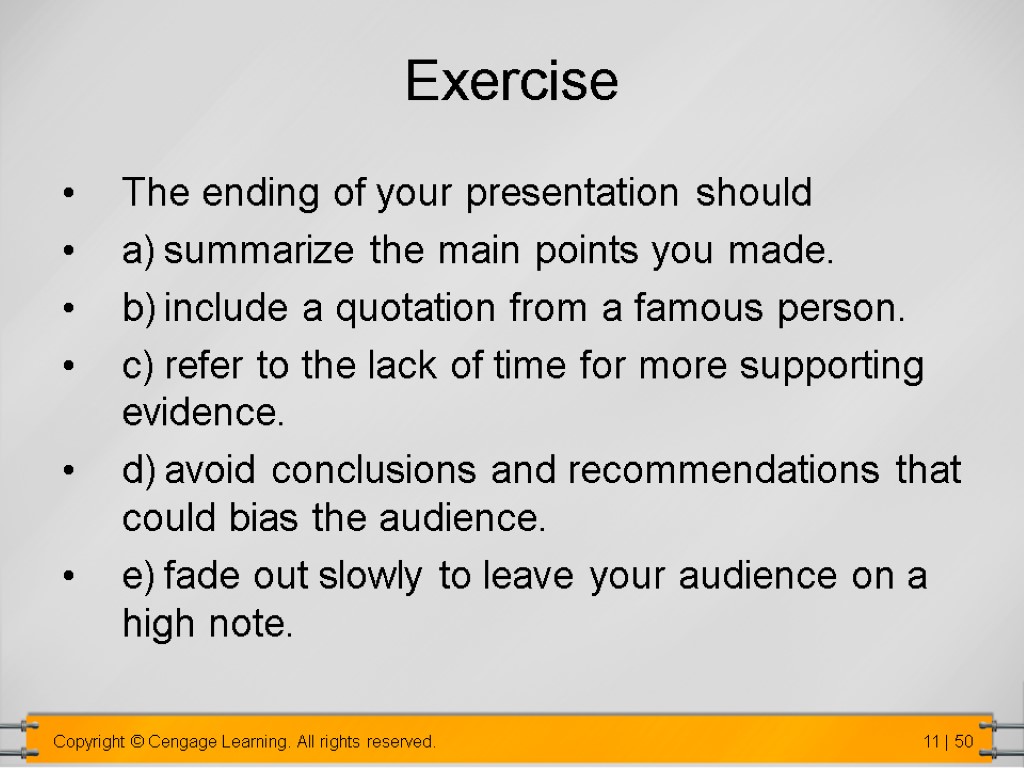
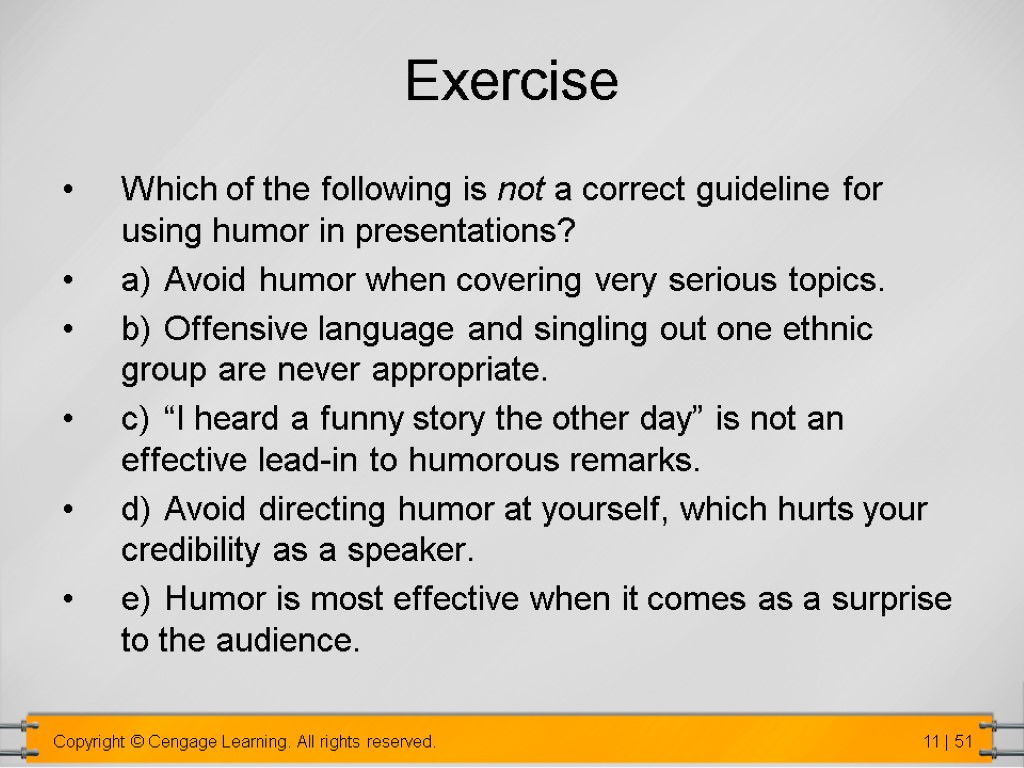

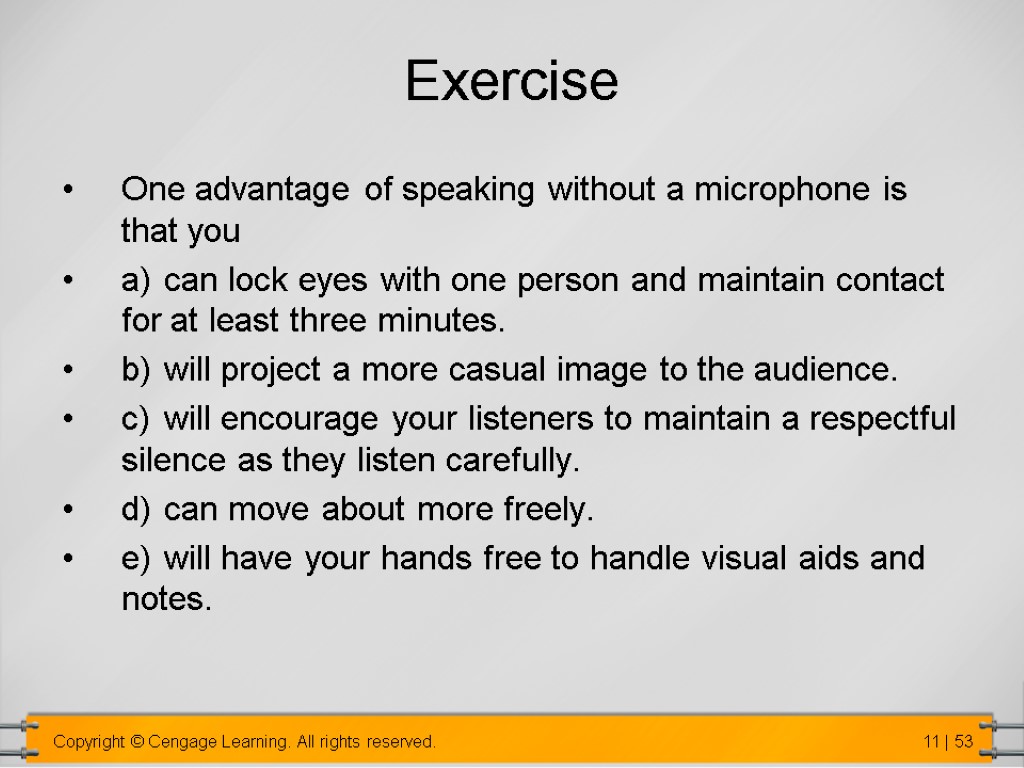
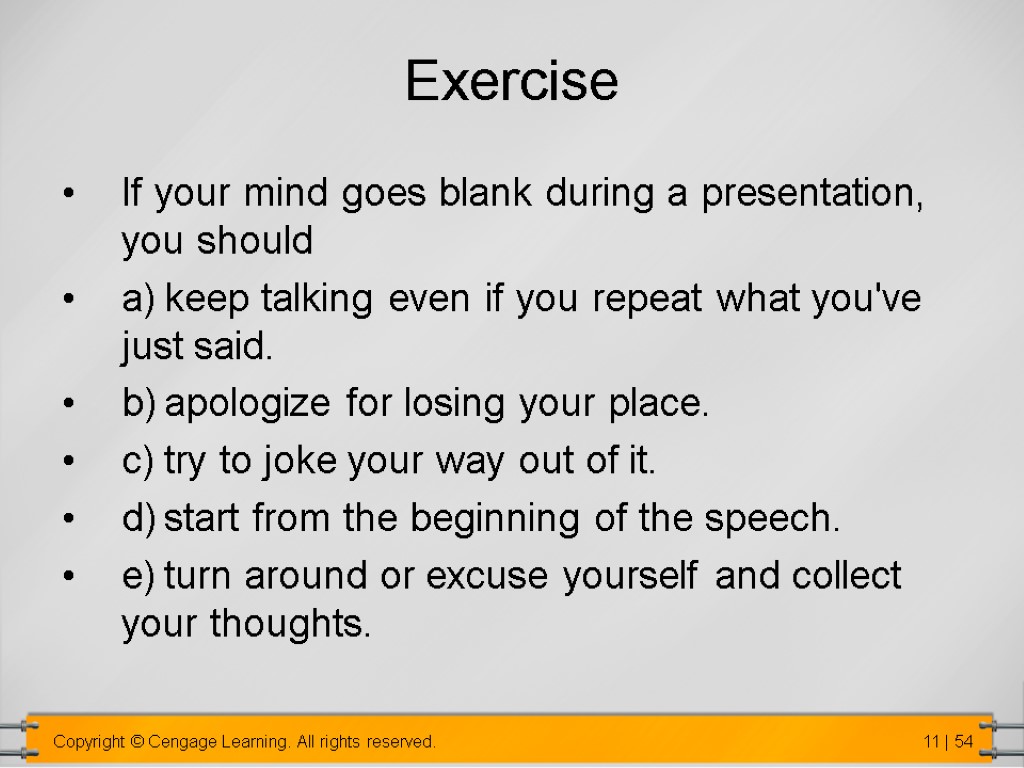
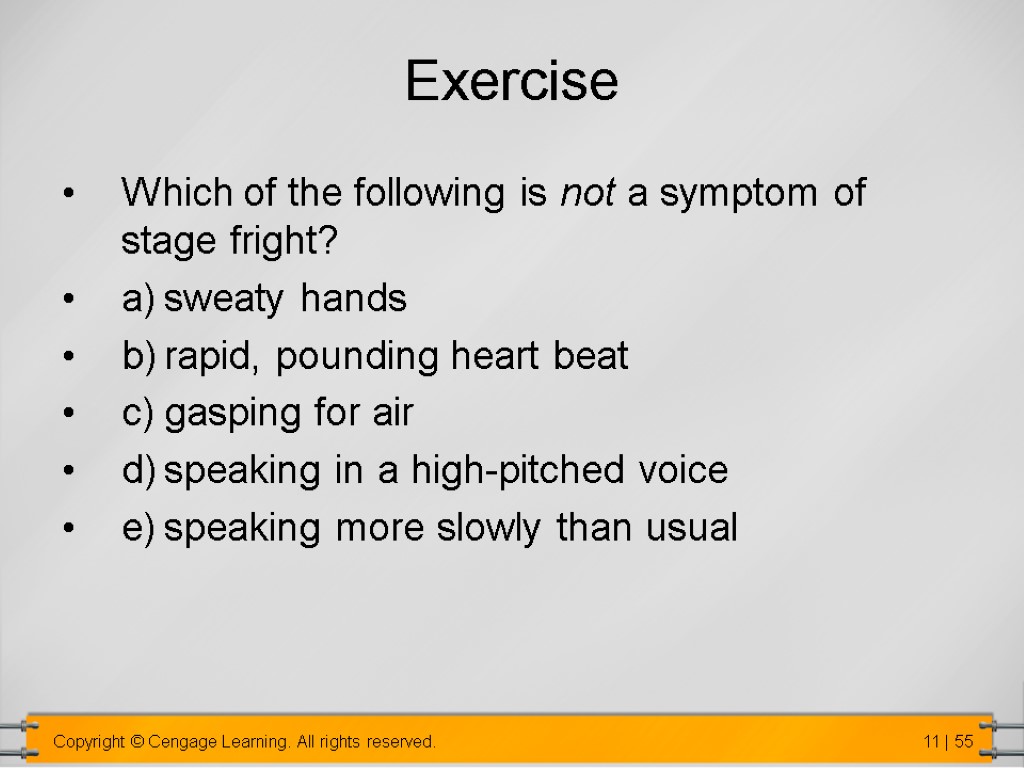

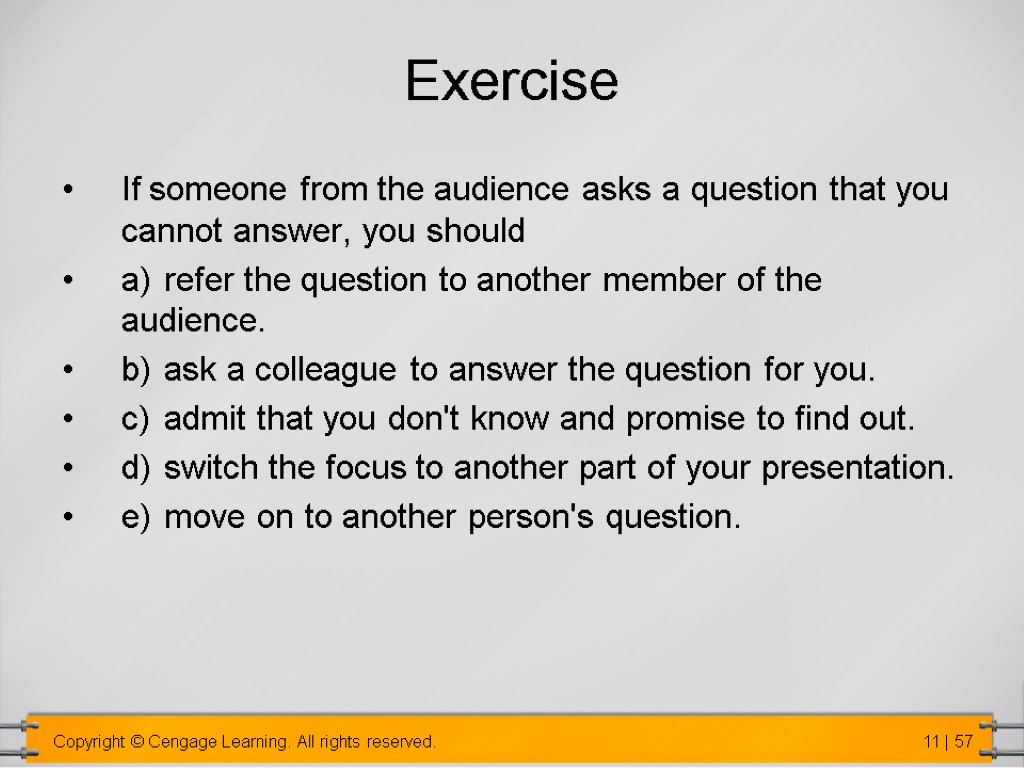
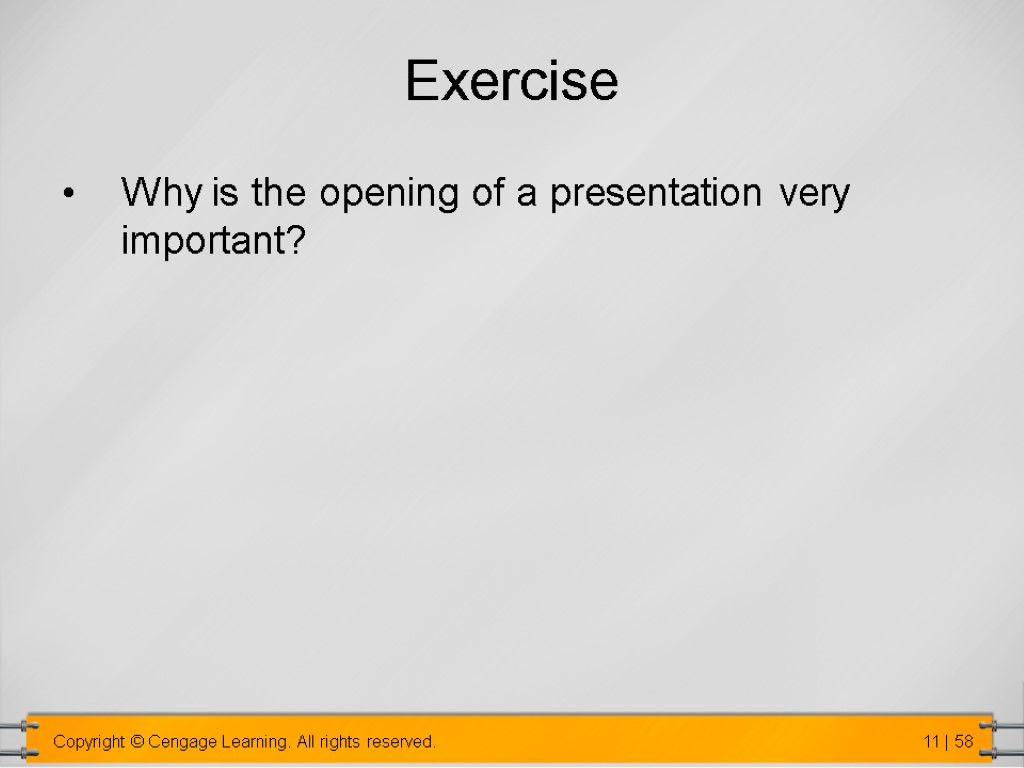
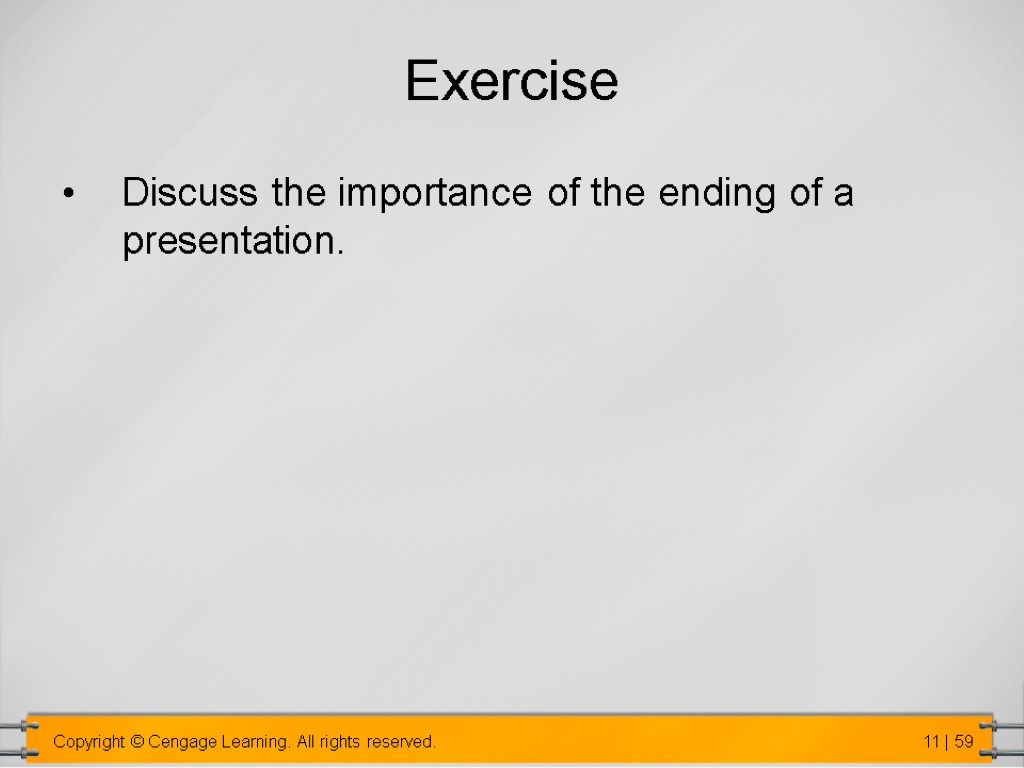

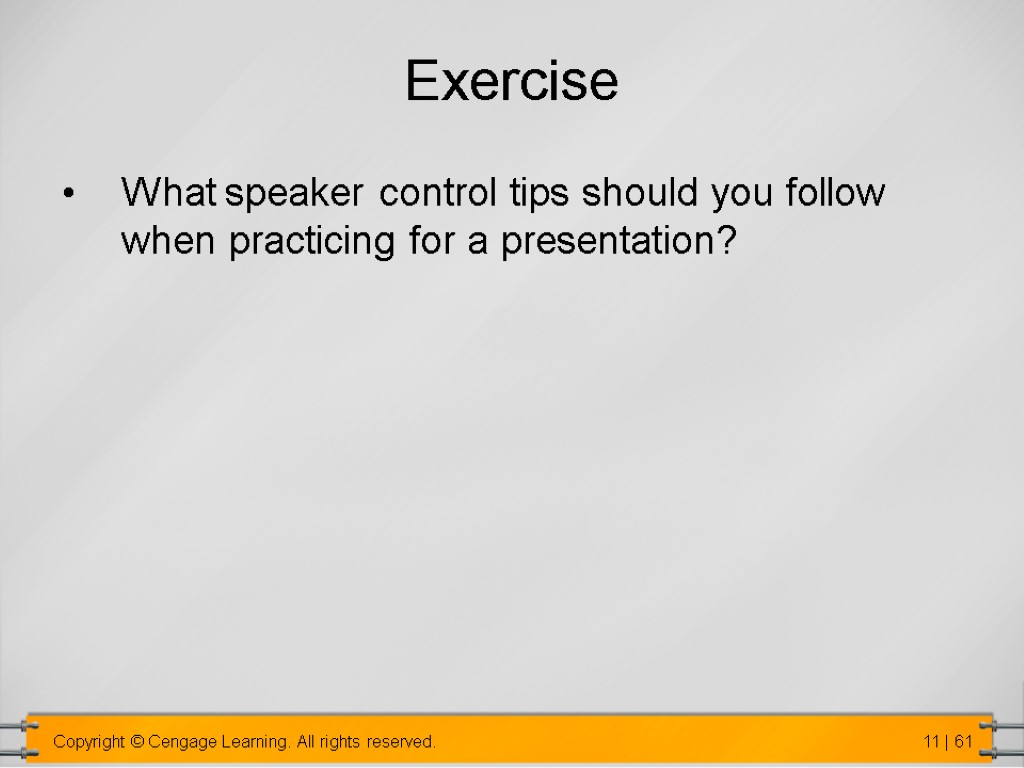
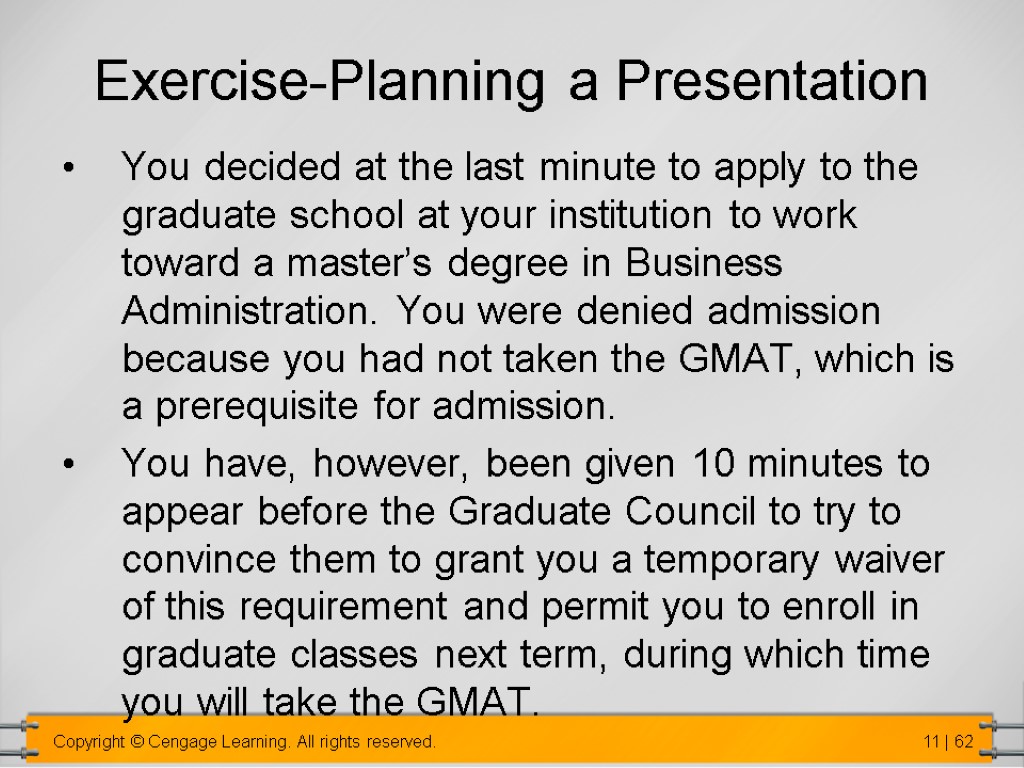
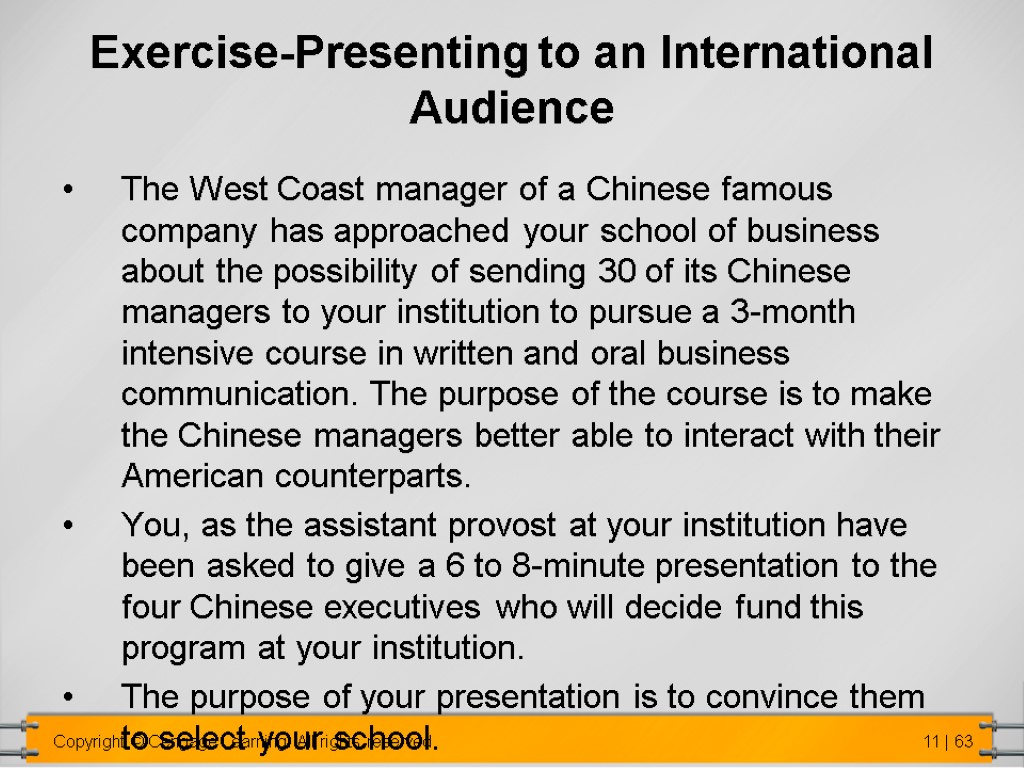
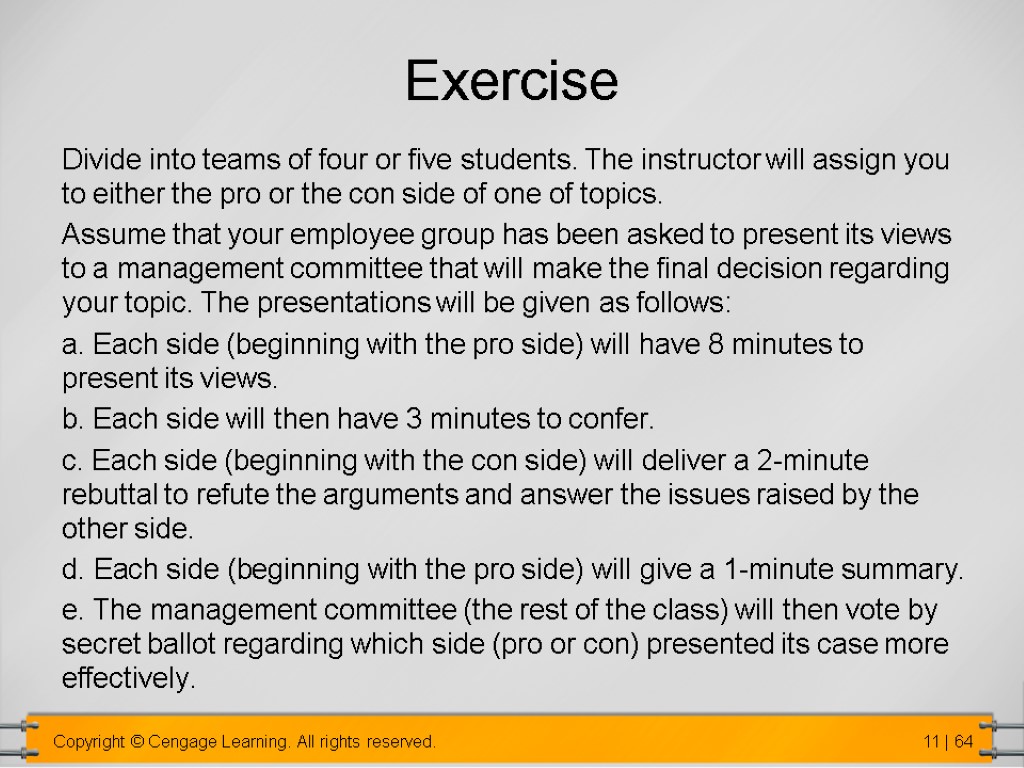
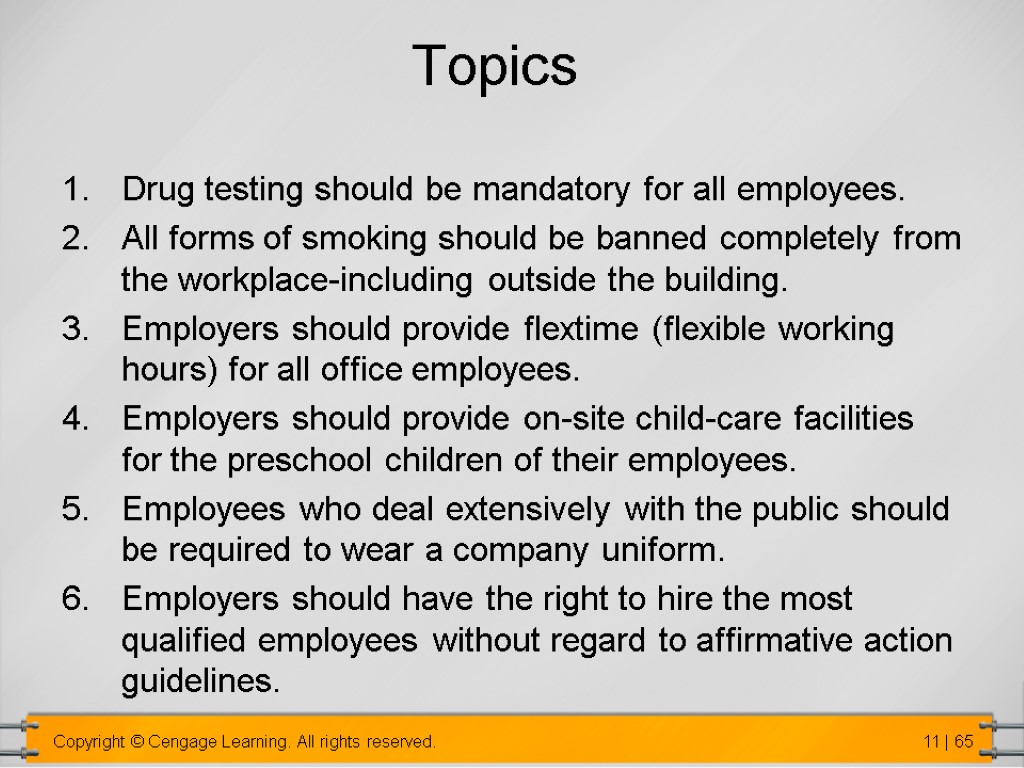
6._make_oral_presentations.ppt
- Количество слайдов: 65
 Chapter 6 Making Oral Presentations
Chapter 6 Making Oral Presentations
 The Role of Business Presentations Just about everyone in business makes some presentations each year. Therefore, the ability to speak effectively is a strategic managerial skill. The costs of ineffective presentations are immense: sales are lost, vital information is not communicated, training programs fail, policies are not implemented, and profits and efficiency drop. Technology has changed the physical characteristics of oral presentations
The Role of Business Presentations Just about everyone in business makes some presentations each year. Therefore, the ability to speak effectively is a strategic managerial skill. The costs of ineffective presentations are immense: sales are lost, vital information is not communicated, training programs fail, policies are not implemented, and profits and efficiency drop. Technology has changed the physical characteristics of oral presentations
 Making oral presentations Plan and organize a presentation. Plan a team presentation. Use visual aids Practice and deliver a presentation.
Making oral presentations Plan and organize a presentation. Plan a team presentation. Use visual aids Practice and deliver a presentation.
 Plan a presentation Explaining Explaining Persuading Persuading Motivating Reporting Purpose Purposes of a report
Plan a presentation Explaining Explaining Persuading Persuading Motivating Reporting Purpose Purposes of a report
 What do you want to accomplish? Reporting: Updating the audience on some project or event. Explaining: Detailing how to carry our a procedure or how to operate a new piece of equipment. Persuading: Convincing the listeners to purchase something or to accept an idea you’re presenting. Motivating: Inspiring the listeners to take some action.
What do you want to accomplish? Reporting: Updating the audience on some project or event. Explaining: Detailing how to carry our a procedure or how to operate a new piece of equipment. Persuading: Convincing the listeners to purchase something or to accept an idea you’re presenting. Motivating: Inspiring the listeners to take some action.
 As you plan and write your presentation, focusing on its purpose helps you decide what information to include, what order to use, and which material to emphasize or subordinate. After your presentation is over, its purpose is the most important criterion to use in judging its effectiveness.
As you plan and write your presentation, focusing on its purpose helps you decide what information to include, what order to use, and which material to emphasize or subordinate. After your presentation is over, its purpose is the most important criterion to use in judging its effectiveness.
 Audience Analysis 1. Analyze the audience by identifying its size, age, organizational status, level of knowledge, and psychological needs. These factors provide clues to overall content, tone, what examples to use, and even how to dress. 2. Consider the effect of your message on your audience and on your credibility with them.
Audience Analysis 1. Analyze the audience by identifying its size, age, organizational status, level of knowledge, and psychological needs. These factors provide clues to overall content, tone, what examples to use, and even how to dress. 2. Consider the effect of your message on your audience and on your credibility with them.
 3. The size and knowledge level of the audience determine the formality of the presentation, the level and speed at which you speak, the gestures you use, the size of your visual aids, and the timing of questions. 4. Look for the key decision maker in the group, and then gear the level of detail to that person’s understanding. Take the time to understand the decision maker’s needs, objectives, and interests as they relate to your objectives.
3. The size and knowledge level of the audience determine the formality of the presentation, the level and speed at which you speak, the gestures you use, the size of your visual aids, and the timing of questions. 4. Look for the key decision maker in the group, and then gear the level of detail to that person’s understanding. Take the time to understand the decision maker’s needs, objectives, and interests as they relate to your objectives.
 Why does an audience get distracted? Speaker believes common knowledge is adequate background Speaker does not make the structure of the presentation clear Speaker does not use visual aids adequately Speaker uses long, complicated sentences and unnecessary jargon, abbreviations, or difficult words Speaker reads too fast and without pacing Source: Adapted from: http://www.efcats.org/pages/presentation/oralpresentation.html, accessed 10/1/07.
Why does an audience get distracted? Speaker believes common knowledge is adequate background Speaker does not make the structure of the presentation clear Speaker does not use visual aids adequately Speaker uses long, complicated sentences and unnecessary jargon, abbreviations, or difficult words Speaker reads too fast and without pacing Source: Adapted from: http://www.efcats.org/pages/presentation/oralpresentation.html, accessed 10/1/07.
 Delivery Method Memorizing Unless a presentation is very short and very important, memorizing an entire speech is risky and time-consuming. Reading 1. Read your speech when the topic is highly complex, technical, or controversial or when you have a lot of information to present in a short time. 2. Reading is not recommended for most business meetings. Speaking from Notes 1. Speaking from notes is the most common (and generally the most effective) method for business presentations. 2. Notes help ensure that all the material is covered in a logical order, yet the method gives you the flexibility to adapt your remarks to audience cues.
Delivery Method Memorizing Unless a presentation is very short and very important, memorizing an entire speech is risky and time-consuming. Reading 1. Read your speech when the topic is highly complex, technical, or controversial or when you have a lot of information to present in a short time. 2. Reading is not recommended for most business meetings. Speaking from Notes 1. Speaking from notes is the most common (and generally the most effective) method for business presentations. 2. Notes help ensure that all the material is covered in a logical order, yet the method gives you the flexibility to adapt your remarks to audience cues.
 Use an outline—not a script Absenteeism Rate—Slide 1 4.7% first 6 mo 5% higher than last yr 14% increase in 3 yrs Industry average = 3.6% (steady)
Use an outline—not a script Absenteeism Rate—Slide 1 4.7% first 6 mo 5% higher than last yr 14% increase in 3 yrs Industry average = 3.6% (steady)
 The opening Quote a well-known person Comedian Woody Allen once noted that 90 percent of the job is just showing up. Ask a question If we were able to cut our absenteeism rate by half during the coming six months, exactly how much do you think that would mean for each of us in our end-of-year bonus checks? Organizing a presentation
The opening Quote a well-known person Comedian Woody Allen once noted that 90 percent of the job is just showing up. Ask a question If we were able to cut our absenteeism rate by half during the coming six months, exactly how much do you think that would mean for each of us in our end-of-year bonus checks? Organizing a presentation
 Present a hypothetical situation Assume that as you were leaving home this morning to put in a full day at work, your son came up to you and said he was too tired to go to school because he had stayed up so late last night watching Wrestle Mania. What would be your reaction?
Present a hypothetical situation Assume that as you were leaving home this morning to put in a full day at work, your son came up to you and said he was too tired to go to school because he had stayed up so late last night watching Wrestle Mania. What would be your reaction?
 Relate an appropriate anecdote, story, joke, or personal experience George, a friend of mine who had recently changed jobs, happened to meet his former boss and asked her whom she had hired to fill his vacancy. “George” his former boss said “ when you left, you didn't leave any vacancy!” Perhaps the reason George didn't leave any vacancy was that..!
Relate an appropriate anecdote, story, joke, or personal experience George, a friend of mine who had recently changed jobs, happened to meet his former boss and asked her whom she had hired to fill his vacancy. “George” his former boss said “ when you left, you didn't leave any vacancy!” Perhaps the reason George didn't leave any vacancy was that..!
 Give a startling fact During the next 24 hours, American industry will lose 136 million because of absenteeism. Use a dramatic prop or visual aid (holding up a paper clip) What do you think is the true cost of this paper clip to our company?
Give a startling fact During the next 24 hours, American industry will lose 136 million because of absenteeism. Use a dramatic prop or visual aid (holding up a paper clip) What do you think is the true cost of this paper clip to our company?
 Don’t lose time at the start Do not repeat the title, explain who you are, or repeat your affiliation, especially if the material is printed or has been verbalized. Plan the opening carefully. Spontaneous statements often fall short of the desired effect. Write the first five minutes in short, powerful, crystal clear sentences, and rehearse several times. Source: Adapted from: http://www.efcats.org/pages/presentation/oralpresentation.html ,accessed 10/1/07.
Don’t lose time at the start Do not repeat the title, explain who you are, or repeat your affiliation, especially if the material is printed or has been verbalized. Plan the opening carefully. Spontaneous statements often fall short of the desired effect. Write the first five minutes in short, powerful, crystal clear sentences, and rehearse several times. Source: Adapted from: http://www.efcats.org/pages/presentation/oralpresentation.html ,accessed 10/1/07.
 The Body In the body of your presentation you develop the points you introduced in the opening and give background information, specific evidence, examples, implications, consequences, and other needed information. For an organizational plan, you can do the following three things.
The Body In the body of your presentation you develop the points you introduced in the opening and give background information, specific evidence, examples, implications, consequences, and other needed information. For an organizational plan, you can do the following three things.
 Choose a logical sequence Criteria: Introduce each criterion and compare alternatives. Direct sequence: Give conclusions first and then supporting details. Indirect sequence: Give reasons first and then major conclusions. Chronology: Present points in the order in which they occurred. Cause/effect/solution: Present sources and consequences of a problem; then pose a solution. Order of importance: Arrange points in order of importance, and then pose each as a question and an answer. Elimination of alternatives: List the alternatives, and then eliminate all but one.
Choose a logical sequence Criteria: Introduce each criterion and compare alternatives. Direct sequence: Give conclusions first and then supporting details. Indirect sequence: Give reasons first and then major conclusions. Chronology: Present points in the order in which they occurred. Cause/effect/solution: Present sources and consequences of a problem; then pose a solution. Order of importance: Arrange points in order of importance, and then pose each as a question and an answer. Elimination of alternatives: List the alternatives, and then eliminate all but one.
 Establish Your Credibility 1. You must support your arguments with credible evidence. 2. Use objective language and emphasis and subordination. 3. Avoid saturating your presentation with so many facts and figures that your audience will not be able to absorb them.
Establish Your Credibility 1. You must support your arguments with credible evidence. 2. Use objective language and emphasis and subordination. 3. Avoid saturating your presentation with so many facts and figures that your audience will not be able to absorb them.
 Deal with Negative Information Present all important information-pro and con-and show, through your analysis and discussion, that your recommendations are still valid, in spite of any negative information.
Deal with Negative Information Present all important information-pro and con-and show, through your analysis and discussion, that your recommendations are still valid, in spite of any negative information.
 The Ending 1. The ending is your last opportunity to achieve your objective by drawing conclusions, making recommendations, or outlining the next steps. 2. Leave the audience with a clear and simple message. 3. Finish on a strong, upbeat note.
The Ending 1. The ending is your last opportunity to achieve your objective by drawing conclusions, making recommendations, or outlining the next steps. 2. Leave the audience with a clear and simple message. 3. Finish on a strong, upbeat note.
 The Use of Humor in Business Presentations 1. When ideas are presented with humor, the audience remembers more details and is likely to retain the information longer. 2. Humor can be used anywhere in a presentation, as long as it is in good taste. 3. Remember that the best humorous stories are directed at yourself. 4. Humor is a means to an end, not an end in itself.
The Use of Humor in Business Presentations 1. When ideas are presented with humor, the audience remembers more details and is likely to retain the information longer. 2. Humor can be used anywhere in a presentation, as long as it is in good taste. 3. Remember that the best humorous stories are directed at yourself. 4. Humor is a means to an end, not an end in itself.
 Work-team presentations The Role of the Team Leader 1. The team leader should be organized, knowledgeable about the topic, and well liked and respected by the team members. 2. The effective team leader will lead the group in developing a cohesive strategy for the entire presentation and preparing a tentative schedule. 3. Work backward from the presentation date in setting deadlines for all team members.
Work-team presentations The Role of the Team Leader 1. The team leader should be organized, knowledgeable about the topic, and well liked and respected by the team members. 2. The effective team leader will lead the group in developing a cohesive strategy for the entire presentation and preparing a tentative schedule. 3. Work backward from the presentation date in setting deadlines for all team members.
 Achieving Coherence 1. The team must ensure that the overall presentation has coherence and unity. It should sound as if it were prepared and given by one individual. 2. Use a presentation template to maintain a consistent “look and feel” across everyone’s slides.
Achieving Coherence 1. The team must ensure that the overall presentation has coherence and unity. It should sound as if it were prepared and given by one individual. 2. Use a presentation template to maintain a consistent “look and feel” across everyone’s slides.
 Practicing the Team Presentation 1. It is crucial to have a full-scale rehearsal in the presentation room early enough to make any changes. 2. Plan transitions from one speaker to the next, and remember that all team members are “on stage” even when on the sidelines. 3. If questions come up during the presentation that you know a team member will answer during a subsequent segment, inform the audience that these points will be covered later in the presentation. 4. Each team member is on stage during the entire presentation, no matter who is presenting at the moment.
Practicing the Team Presentation 1. It is crucial to have a full-scale rehearsal in the presentation room early enough to make any changes. 2. Plan transitions from one speaker to the next, and remember that all team members are “on stage” even when on the sidelines. 3. If questions come up during the presentation that you know a team member will answer during a subsequent segment, inform the audience that these points will be covered later in the presentation. 4. Each team member is on stage during the entire presentation, no matter who is presenting at the moment.
 Visual Aids for Business Presentations 1. Electronic presentations are the standard medium for visual aids. They are shown directly from a computer onto a screen and offer greater flexibility. 2. When preparing an electronic presentation, check colors for accuracy, keep special effects simple, avoid sound effects, and disable any screensavers or shutdown features of your computer. During the session, stand where you can be seen and heard.
Visual Aids for Business Presentations 1. Electronic presentations are the standard medium for visual aids. They are shown directly from a computer onto a screen and offer greater flexibility. 2. When preparing an electronic presentation, check colors for accuracy, keep special effects simple, avoid sound effects, and disable any screensavers or shutdown features of your computer. During the session, stand where you can be seen and heard.
 Preparing Visual Aids 1. Avoid using too many visual aids. 2. Avoid reproducing tables or illustrations from reports, because print graphs contain too much information. 3. Limit content to 40 characters per line, no more than 6 lines, and no more than three columns of data. 4. Do not use all capitals, and choose a simple, consistent typeface and color scheme. 5. Test the readability of the material from the back of the room.
Preparing Visual Aids 1. Avoid using too many visual aids. 2. Avoid reproducing tables or illustrations from reports, because print graphs contain too much information. 3. Limit content to 40 characters per line, no more than 6 lines, and no more than three columns of data. 4. Do not use all capitals, and choose a simple, consistent typeface and color scheme. 5. Test the readability of the material from the back of the room.
 Using visual aids 1. Practice with the equipment until you can operate it smoothly, be sure it works correctly, and know where to get replacement parts or equipment or help when something goes wrong.
Using visual aids 1. Practice with the equipment until you can operate it smoothly, be sure it works correctly, and know where to get replacement parts or equipment or help when something goes wrong.
 2. Adjust the focus beforehand to be sure the picture does not overflow the screen. 3. Stand out of the way of the projector so as not to cut the audience’s view. 4. Anticipate alternative presentation modes for possible problems-including having to give your presentation without your slides. 5. Face the audience, and turn from the waist when referring to a visual.
2. Adjust the focus beforehand to be sure the picture does not overflow the screen. 3. Stand out of the way of the projector so as not to cut the audience’s view. 4. Anticipate alternative presentation modes for possible problems-including having to give your presentation without your slides. 5. Face the audience, and turn from the waist when referring to a visual.
 Visual aids in your presentation Use visuals as an AID not a CRUTCH for your presentation. Use visual aids sparingly. Use visual aids pictorially. Present one key point per visual, keeping the focus simple and clear. Use a legible font for text and numbers keeping the size to a minimum of 18 pt. for most rooms. Make visuals (pictures and diagrams) large enough to see from the last row. Source: Adapted from: http://clc.cqu.edu.au/FCWViewer/view.do?page=850, accessed 10/1/07.
Visual aids in your presentation Use visuals as an AID not a CRUTCH for your presentation. Use visual aids sparingly. Use visual aids pictorially. Present one key point per visual, keeping the focus simple and clear. Use a legible font for text and numbers keeping the size to a minimum of 18 pt. for most rooms. Make visuals (pictures and diagrams) large enough to see from the last row. Source: Adapted from: http://clc.cqu.edu.au/FCWViewer/view.do?page=850, accessed 10/1/07.
 Visual aids in your presentation (cont’d ) Use no more than 3 to 4 colors per visual aid to avoid a cluttered, rainbow effect. Make visuals attractive, aiming for simplicity and clarity. Use graphs rather than tables for numerical data. If something can be stated simply and verbally, there is no need for a visual aid. Source: Adapted from: http://clc.cqu.edu.au/FCWViewer/view.do?page=850, accessed 10/1/07.
Visual aids in your presentation (cont’d ) Use no more than 3 to 4 colors per visual aid to avoid a cluttered, rainbow effect. Make visuals attractive, aiming for simplicity and clarity. Use graphs rather than tables for numerical data. If something can be stated simply and verbally, there is no need for a visual aid. Source: Adapted from: http://clc.cqu.edu.au/FCWViewer/view.do?page=850, accessed 10/1/07.
 Practicing the Presentation 1. Use short, simple sentences; simple vocabulary; and a conversational style. 2. Use previews, summary, transition, and repetition to help the audience follow the presentation. 3. Remember that 55 percent of your credibility with an audience comes from your body language, 38 percent from your voice qualities, and only 7 percent from the actual words you use. 4. Plan on a minimum of three run-throughs. 5. Speak in a conversational tone but at a slightly slower rate than usual.
Practicing the Presentation 1. Use short, simple sentences; simple vocabulary; and a conversational style. 2. Use previews, summary, transition, and repetition to help the audience follow the presentation. 3. Remember that 55 percent of your credibility with an audience comes from your body language, 38 percent from your voice qualities, and only 7 percent from the actual words you use. 4. Plan on a minimum of three run-throughs. 5. Speak in a conversational tone but at a slightly slower rate than usual.
 6. Use periodic pauses to emphasize important points. 7. Use correct diction. 8. Use occasional gestures to add interest and emphasis. 9. Position yourself to the audience’s left with visuals to the right. 10. Practice smiling occasionally and standing tall and naturally with your body balanced on both feet.
6. Use periodic pauses to emphasize important points. 7. Use correct diction. 8. Use occasional gestures to add interest and emphasis. 9. Position yourself to the audience’s left with visuals to the right. 10. Practice smiling occasionally and standing tall and naturally with your body balanced on both feet.
 Delivering the Presentation 1. Your clothing is part of the message that you communicate to your audience, so dress appropriately in comfortable and businesslike attire. 2. Before you begin, take time to arrange yourself and your notes, look slowly around you, and establish eye contact with several members of the audience. Then, in a loud, clear voice, begin your presentation. 3. If your mind goes blank, keep talking, or skip ahead to a part you do remember. Later you can come back to the part you forgot.
Delivering the Presentation 1. Your clothing is part of the message that you communicate to your audience, so dress appropriately in comfortable and businesslike attire. 2. Before you begin, take time to arrange yourself and your notes, look slowly around you, and establish eye contact with several members of the audience. Then, in a loud, clear voice, begin your presentation. 3. If your mind goes blank, keep talking, or skip ahead to a part you do remember. Later you can come back to the part you forgot.
 Dealing with stage fright 1. The best way to overcome anxiety is to overprepare. 2. Memorize the first several sentences of the presentation so you can approach the critical first moments with more confidence. 3. Practice mental imagery, visualizing yourself giving your speech.
Dealing with stage fright 1. The best way to overcome anxiety is to overprepare. 2. Memorize the first several sentences of the presentation so you can approach the critical first moments with more confidence. 3. Practice mental imagery, visualizing yourself giving your speech.
 Answering Questions 1. Normally, answer questions at the end of the presentation to avoid interruptions or running out of time. 2. If the topic is so complex that unless a listener’s question is answered immediately he or she will not be able to follow the remainder of the presentation, it may be necessary to stop and answer questions during the presentation.
Answering Questions 1. Normally, answer questions at the end of the presentation to avoid interruptions or running out of time. 2. If the topic is so complex that unless a listener’s question is answered immediately he or she will not be able to follow the remainder of the presentation, it may be necessary to stop and answer questions during the presentation.
 3. During preparation, anticipate questions you think the audience will ask, and generate possible answers. 4. If you do not know the answer to a question, say so and then promise to find it out. 5. If there are no questions asked, attempt to break the ice by presenting one that others have asked previously.
3. During preparation, anticipate questions you think the audience will ask, and generate possible answers. 4. If you do not know the answer to a question, say so and then promise to find it out. 5. If there are no questions asked, attempt to break the ice by presenting one that others have asked previously.
 4. Take a short walk before the presentation to relax. 5. While you are waiting to start, let your arms drop loosely by your sides and shake your wrists gently, all the while breathing deeply several times. 6. Concentrate on friendly faces in the crowd.
4. Take a short walk before the presentation to relax. 5. While you are waiting to start, let your arms drop loosely by your sides and shake your wrists gently, all the while breathing deeply several times. 6. Concentrate on friendly faces in the crowd.
 Relaxation exercises Relaxation exercises are useful to ward off last- minute anxiety attacks while you are waiting at the head table to "go on." Concentrate on a toe. Consciously relax it then move on to another toe. When you have done all ten, continue to the feet and ankles until you work your way to your waist. A variation on this exercise is to tense each body part briefly and then relax it. Do deep- and slow-breathing exercises. These can be combined with the above. Source: Adapted from: Wallace, Marie. Guide on the Side - How to Turn Stage Fright into Peak Performance, March 1, 1998 http://www.llrx.com/columns/guide14.htm, accessed 10/1/07.
Relaxation exercises Relaxation exercises are useful to ward off last- minute anxiety attacks while you are waiting at the head table to "go on." Concentrate on a toe. Consciously relax it then move on to another toe. When you have done all ten, continue to the feet and ankles until you work your way to your waist. A variation on this exercise is to tense each body part briefly and then relax it. Do deep- and slow-breathing exercises. These can be combined with the above. Source: Adapted from: Wallace, Marie. Guide on the Side - How to Turn Stage Fright into Peak Performance, March 1, 1998 http://www.llrx.com/columns/guide14.htm, accessed 10/1/07.
 Relaxation exercises (contd.) More active exercises can be done when you are not on stage and there is no audience. Stretches of all kinds Shake limbs (feet, legs, hands, arms) one at a time Shoulder and neck rolls Arm swings Yoga Source: Adapted from: Wallace, Marie. Guide on the Side - How to Turn Stage Fright into Peak Performance, March 1, 1998 http://www.llrx.com/columns/guide14.htm, accessed 10/1/07.
Relaxation exercises (contd.) More active exercises can be done when you are not on stage and there is no audience. Stretches of all kinds Shake limbs (feet, legs, hands, arms) one at a time Shoulder and neck rolls Arm swings Yoga Source: Adapted from: Wallace, Marie. Guide on the Side - How to Turn Stage Fright into Peak Performance, March 1, 1998 http://www.llrx.com/columns/guide14.htm, accessed 10/1/07.
 Exercise A publisher's presentation to a group of authors to describe how the publishing process works has the purpose of a) reporting. b) explaining. c) persuading. d) motivating. e) enhancing.
Exercise A publisher's presentation to a group of authors to describe how the publishing process works has the purpose of a) reporting. b) explaining. c) persuading. d) motivating. e) enhancing.
 Exercise A presentation in which sales representatives receive up-to-date information on new products has the purpose of a) reporting. b) explaining. c) lecturing. d) persuading. e) motivating.
Exercise A presentation in which sales representatives receive up-to-date information on new products has the purpose of a) reporting. b) explaining. c) lecturing. d) persuading. e) motivating.
 Exercise You may be extremely effective if you memorize the ____ of your presentation. a) first or last section b) body c) supporting details d) key phrases e) script
Exercise You may be extremely effective if you memorize the ____ of your presentation. a) first or last section b) body c) supporting details d) key phrases e) script
 Exercise If you memorize your presentation for delivery, you may a) include too many details in the body of the speech. b) have greater flexibility than with other delivery methods. c) have your eyes on your speech rather than on the audience. d) sound mechanical and lack spontaneity. e) read from your notes to prompt your memory.
Exercise If you memorize your presentation for delivery, you may a) include too many details in the body of the speech. b) have greater flexibility than with other delivery methods. c) have your eyes on your speech rather than on the audience. d) sound mechanical and lack spontaneity. e) read from your notes to prompt your memory.
 Exercise Which of the following is not a recommended guideline for preparing notes for a presentation? a) Number the pages or index cards. b) Use large letters on your note cards. c) Type the notes in all capital letters for easy reading. d) Write on only one side of the note card. e) Consider including notes about emphasis and pauses.
Exercise Which of the following is not a recommended guideline for preparing notes for a presentation? a) Number the pages or index cards. b) Use large letters on your note cards. c) Type the notes in all capital letters for easy reading. d) Write on only one side of the note card. e) Consider including notes about emphasis and pauses.
 Exercise Which opening sentence weakens your credibility as a speaker? a) Give us liberty, or give us death. b) During the next hour, 30 people will die in car crashes. c) How many people feel tied to their cell phones? d) I wish I had had more time to prepare for this presentation. e) Today, I'll cover three ways to get the most from your paycheck.
Exercise Which opening sentence weakens your credibility as a speaker? a) Give us liberty, or give us death. b) During the next hour, 30 people will die in car crashes. c) How many people feel tied to their cell phones? d) I wish I had had more time to prepare for this presentation. e) Today, I'll cover three ways to get the most from your paycheck.
 Exercise A presentation that first mentions unsafe working conditions and how unsafe conditions contribute to high employee turnover, followed by suggested remedies, follows the ____ organizational plan. a) criteria b) order of importance c) direct sequence d) chronological e) cause/effect/solution
Exercise A presentation that first mentions unsafe working conditions and how unsafe conditions contribute to high employee turnover, followed by suggested remedies, follows the ____ organizational plan. a) criteria b) order of importance c) direct sequence d) chronological e) cause/effect/solution
 Exercise Which of the following is not credible evidence that you can use to support a point in your presentation? a) specific examples b) actual experiences c) facts and statistics d) emotional language e) quotations from experts
Exercise Which of the following is not credible evidence that you can use to support a point in your presentation? a) specific examples b) actual experiences c) facts and statistics d) emotional language e) quotations from experts
 Exercise When you know that a proposal you are presenting has several negative aspects, you a) must address each point in great detail to avoid losing credibility. b) should disregard or discredit the negative points as you build your case. c) should mention important pros and cons and show that your proposal is still valid. d) can effectively weaken the argument against any unsupportive evidence. e) should wait to discuss these points if questions about them arise.
Exercise When you know that a proposal you are presenting has several negative aspects, you a) must address each point in great detail to avoid losing credibility. b) should disregard or discredit the negative points as you build your case. c) should mention important pros and cons and show that your proposal is still valid. d) can effectively weaken the argument against any unsupportive evidence. e) should wait to discuss these points if questions about them arise.
 Exercise The ending of your presentation should a) summarize the main points you made. b) include a quotation from a famous person. c) refer to the lack of time for more supporting evidence. d) avoid conclusions and recommendations that could bias the audience. e) fade out slowly to leave your audience on a high note.
Exercise The ending of your presentation should a) summarize the main points you made. b) include a quotation from a famous person. c) refer to the lack of time for more supporting evidence. d) avoid conclusions and recommendations that could bias the audience. e) fade out slowly to leave your audience on a high note.
 Exercise Which of the following is not a correct guideline for using humor in presentations? a) Avoid humor when covering very serious topics. b) Offensive language and singling out one ethnic group are never appropriate. c) “I heard a funny story the other day” is not an effective lead-in to humorous remarks. d) Avoid directing humor at yourself, which hurts your credibility as a speaker. e) Humor is most effective when it comes as a surprise to the audience.
Exercise Which of the following is not a correct guideline for using humor in presentations? a) Avoid humor when covering very serious topics. b) Offensive language and singling out one ethnic group are never appropriate. c) “I heard a funny story the other day” is not an effective lead-in to humorous remarks. d) Avoid directing humor at yourself, which hurts your credibility as a speaker. e) Humor is most effective when it comes as a surprise to the audience.
 Exercise Identify the correct statement about collaborative presentations. a) The coordinator should ensure that all group members receive equal “podium time” during the presentation. b) To avoid problems, each member should be involved with all aspects of the presentation. c) As long as individual members practice their sections, a full rehearsal is not necessary. d) The overall presentation should look as if it were prepared and delivered by one individual. e) Provide definite breaks between speakers and between topics to allow the audience time for reflection.
Exercise Identify the correct statement about collaborative presentations. a) The coordinator should ensure that all group members receive equal “podium time” during the presentation. b) To avoid problems, each member should be involved with all aspects of the presentation. c) As long as individual members practice their sections, a full rehearsal is not necessary. d) The overall presentation should look as if it were prepared and delivered by one individual. e) Provide definite breaks between speakers and between topics to allow the audience time for reflection.
 Exercise One advantage of speaking without a microphone is that you a) can lock eyes with one person and maintain contact for at least three minutes. b) will project a more casual image to the audience. c) will encourage your listeners to maintain a respectful silence as they listen carefully. d) can move about more freely. e) will have your hands free to handle visual aids and notes.
Exercise One advantage of speaking without a microphone is that you a) can lock eyes with one person and maintain contact for at least three minutes. b) will project a more casual image to the audience. c) will encourage your listeners to maintain a respectful silence as they listen carefully. d) can move about more freely. e) will have your hands free to handle visual aids and notes.
 Exercise If your mind goes blank during a presentation, you should a) keep talking even if you repeat what you've just said. b) apologize for losing your place. c) try to joke your way out of it. d) start from the beginning of the speech. e) turn around or excuse yourself and collect your thoughts.
Exercise If your mind goes blank during a presentation, you should a) keep talking even if you repeat what you've just said. b) apologize for losing your place. c) try to joke your way out of it. d) start from the beginning of the speech. e) turn around or excuse yourself and collect your thoughts.
 Exercise Which of the following is not a symptom of stage fright? a) sweaty hands b) rapid, pounding heart beat c) gasping for air d) speaking in a high-pitched voice e) speaking more slowly than usual
Exercise Which of the following is not a symptom of stage fright? a) sweaty hands b) rapid, pounding heart beat c) gasping for air d) speaking in a high-pitched voice e) speaking more slowly than usual
 Exercise A good way to minimize your anxiety about giving a presentation is to a) tell the audience how nervous you are. b) consider that people will remember how you speak, not what you say. c) avoid eye contact with audience members. d) overprepare by practicing frequently. e) remember that audiences sympathize with and trust a presenter who lacks confidence.
Exercise A good way to minimize your anxiety about giving a presentation is to a) tell the audience how nervous you are. b) consider that people will remember how you speak, not what you say. c) avoid eye contact with audience members. d) overprepare by practicing frequently. e) remember that audiences sympathize with and trust a presenter who lacks confidence.
 Exercise If someone from the audience asks a question that you cannot answer, you should a) refer the question to another member of the audience. b) ask a colleague to answer the question for you. c) admit that you don't know and promise to find out. d) switch the focus to another part of your presentation. e) move on to another person's question.
Exercise If someone from the audience asks a question that you cannot answer, you should a) refer the question to another member of the audience. b) ask a colleague to answer the question for you. c) admit that you don't know and promise to find out. d) switch the focus to another part of your presentation. e) move on to another person's question.
 Exercise Why is the opening of a presentation very important?
Exercise Why is the opening of a presentation very important?
 Exercise Discuss the importance of the ending of a presentation.
Exercise Discuss the importance of the ending of a presentation.
 Exercise What are some things to keep in mind about using humor in an oral presentation?
Exercise What are some things to keep in mind about using humor in an oral presentation?
 Exercise What speaker control tips should you follow when practicing for a presentation?
Exercise What speaker control tips should you follow when practicing for a presentation?
 Exercise-Planning a Presentation You decided at the last minute to apply to the graduate school at your institution to work toward a master’s degree in Business Administration. You were denied admission because you had not taken the GMAT, which is a prerequisite for admission. You have, however, been given 10 minutes to appear before the Graduate Council to try to convince them to grant you a temporary waiver of this requirement and permit you to enroll in graduate classes next term, during which time you will take the GMAT.
Exercise-Planning a Presentation You decided at the last minute to apply to the graduate school at your institution to work toward a master’s degree in Business Administration. You were denied admission because you had not taken the GMAT, which is a prerequisite for admission. You have, however, been given 10 minutes to appear before the Graduate Council to try to convince them to grant you a temporary waiver of this requirement and permit you to enroll in graduate classes next term, during which time you will take the GMAT.
 Exercise-Presenting to an International Audience The West Coast manager of a Chinese famous company has approached your school of business about the possibility of sending 30 of its Chinese managers to your institution to pursue a 3-month intensive course in written and oral business communication. The purpose of the course is to make the Chinese managers better able to interact with their American counterparts. You, as the assistant provost at your institution have been asked to give a 6 to 8-minute presentation to the four Chinese executives who will decide fund this program at your institution. The purpose of your presentation is to convince them to select your school.
Exercise-Presenting to an International Audience The West Coast manager of a Chinese famous company has approached your school of business about the possibility of sending 30 of its Chinese managers to your institution to pursue a 3-month intensive course in written and oral business communication. The purpose of the course is to make the Chinese managers better able to interact with their American counterparts. You, as the assistant provost at your institution have been asked to give a 6 to 8-minute presentation to the four Chinese executives who will decide fund this program at your institution. The purpose of your presentation is to convince them to select your school.
 Exercise Divide into teams of four or five students. The instructor will assign you to either the pro or the con side of one of topics. Assume that your employee group has been asked to present its views to a management committee that will make the final decision regarding your topic. The presentations will be given as follows: a. Each side (beginning with the pro side) will have 8 minutes to present its views. b. Each side will then have 3 minutes to confer. c. Each side (beginning with the con side) will deliver a 2-minute rebuttal to refute the arguments and answer the issues raised by the other side. d. Each side (beginning with the pro side) will give a 1-minute summary. e. The management committee (the rest of the class) will then vote by secret ballot regarding which side (pro or con) presented its case more effectively.
Exercise Divide into teams of four or five students. The instructor will assign you to either the pro or the con side of one of topics. Assume that your employee group has been asked to present its views to a management committee that will make the final decision regarding your topic. The presentations will be given as follows: a. Each side (beginning with the pro side) will have 8 minutes to present its views. b. Each side will then have 3 minutes to confer. c. Each side (beginning with the con side) will deliver a 2-minute rebuttal to refute the arguments and answer the issues raised by the other side. d. Each side (beginning with the pro side) will give a 1-minute summary. e. The management committee (the rest of the class) will then vote by secret ballot regarding which side (pro or con) presented its case more effectively.
 Topics Drug testing should be mandatory for all employees. All forms of smoking should be banned completely from the workplace-including outside the building. Employers should provide flextime (flexible working hours) for all office employees. Employers should provide on-site child-care facilities for the preschool children of their employees. Employees who deal extensively with the public should be required to wear a company uniform. Employers should have the right to hire the most qualified employees without regard to affirmative action guidelines.
Topics Drug testing should be mandatory for all employees. All forms of smoking should be banned completely from the workplace-including outside the building. Employers should provide flextime (flexible working hours) for all office employees. Employers should provide on-site child-care facilities for the preschool children of their employees. Employees who deal extensively with the public should be required to wear a company uniform. Employers should have the right to hire the most qualified employees without regard to affirmative action guidelines.

